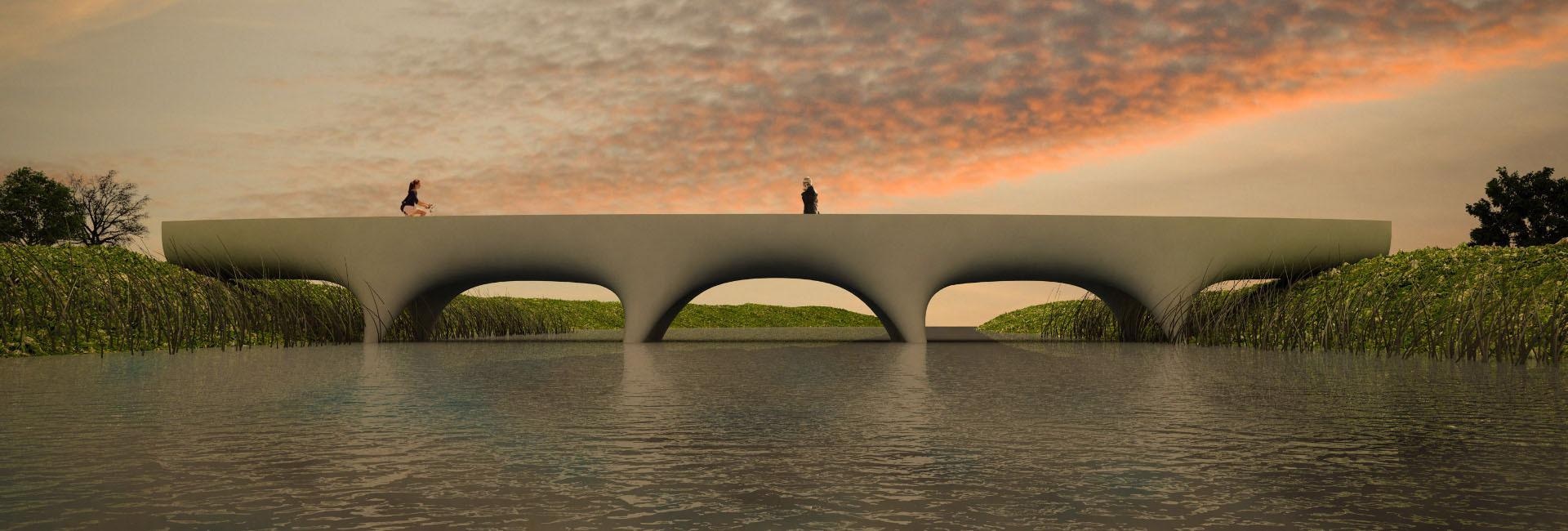
Image Credit: Pim Feijen
Construction of the world's longest 3D printed pedestrian concrete bridge is underway in the Netherlands. The project points to a bright future for the unification between building and 3D printing.
3D printing is becoming an increasingly important element of our modern lives, from tiny applications like the development of 3D printed aortic valves to the truly massive projects such as the Apis Cor structure in Dubai with a floor area of 640 square meters.
A newly commissioned 3D printed concrete bridge¹ in the Netherlands definitely fits within the latter category. The 29 meter long structure, which is being constructed in Eindhoven for use in Nijmegen — one of the country's oldest cities — will be the world's longest 3D printed concrete pedestrian bridge upon completion.
The aptly-named 'Bridge Project' initiative is part of a collaboration between Eindhoven University of Technology (TU/e), Rijkswaterstaat — the Dutch Ministry of Infrastructure and Water Management — and designer Michiel van der Kley.
The Bridge Project aims to innovate and apply novel production methods like concrete 3D printing and apply them in the building industry.
The team hopes that the bridge will be one of many 3D printed concrete structures that emerge from the collaboration, with van der Kley, in particular, aiming to apply the technique used to produce larger structures.
As 2018's Green Capital of Europe, Nijmegen is the perfect location to showcase such new, environmentally friendly building techniques. The bridge will serve as a striking memorial to the city's recognition as a global green trend-setter.
Breaking the Mold with 3D Printing
Michiel van der Klay explains that as part of the Bridge Project he was looking for designs that would be impossible to make using traditional building methods alone.
"Most concrete constructions are being made with the aid of molds," the designer says on his website. "The molds are not only expensive, but they are also partly responsible for a bigger uniformity."
Because 3D printing stacks materials in thin strips layer by layer, the use of a mold isn't required. Additionally, 3D printing allows objects to be constructed piece by piece and then assembled. Both of these elements of 3D printing create vast opportunities to add variety to structures.
This design freedom enables designers to maximize their creativity and develop structures comprised of model pieces that, whilst clearly coming from the same family, are also distinct.
The advantages of 3D printing in architecture aren't just aesthetic and artistic, however. Nor are the challenges.
The Practical Side of 3D Printing in Building Projects
Applying 3D printing methods to the building industry is expected to result in better working conditions and improved safety for workers. On top of this, structures that are more durable can be created more rapidly and at a reduced cost.
Yet, projects uniting building requirements and 3D printing techniques bring with them new and unique challenges that must be overcome. This includes developing a new approach to structural safety.
To properly assess the challenges presented by the Bridge Project, Summum Engineering — a structural design, engineering, and optimization consultancy, based in Rotterdam — set about developing a well-parameterized model of the final construct.
The model conformed to structural constraints described by Witteveen+Bos — the project's engineers — and specifications laid out by researchers at TU/e. This allowed the bridge's geometry to be generated and thus practically observed and assessed.
Construction of the bridge continues at the 3D printing facility of Weber Beamix and Royal BAM Group in Eindhoven, joining a number of large-scale 3D printing-powered building projects underway across the globe. Thus, the future of such projects and the unification of creativity and practical benefits they provide look bright indeed.
References
1. Bridge Project, Michiel van der Kley,[http://www.michielvanderkley.nl/bridge-project/]
Disclaimer: The views expressed here are those of the author expressed in their private capacity and do not necessarily represent the views of AZoM.com Limited T/A AZoNetwork the owner and operator of this website. This disclaimer forms part of the Terms and conditions of use of this website.